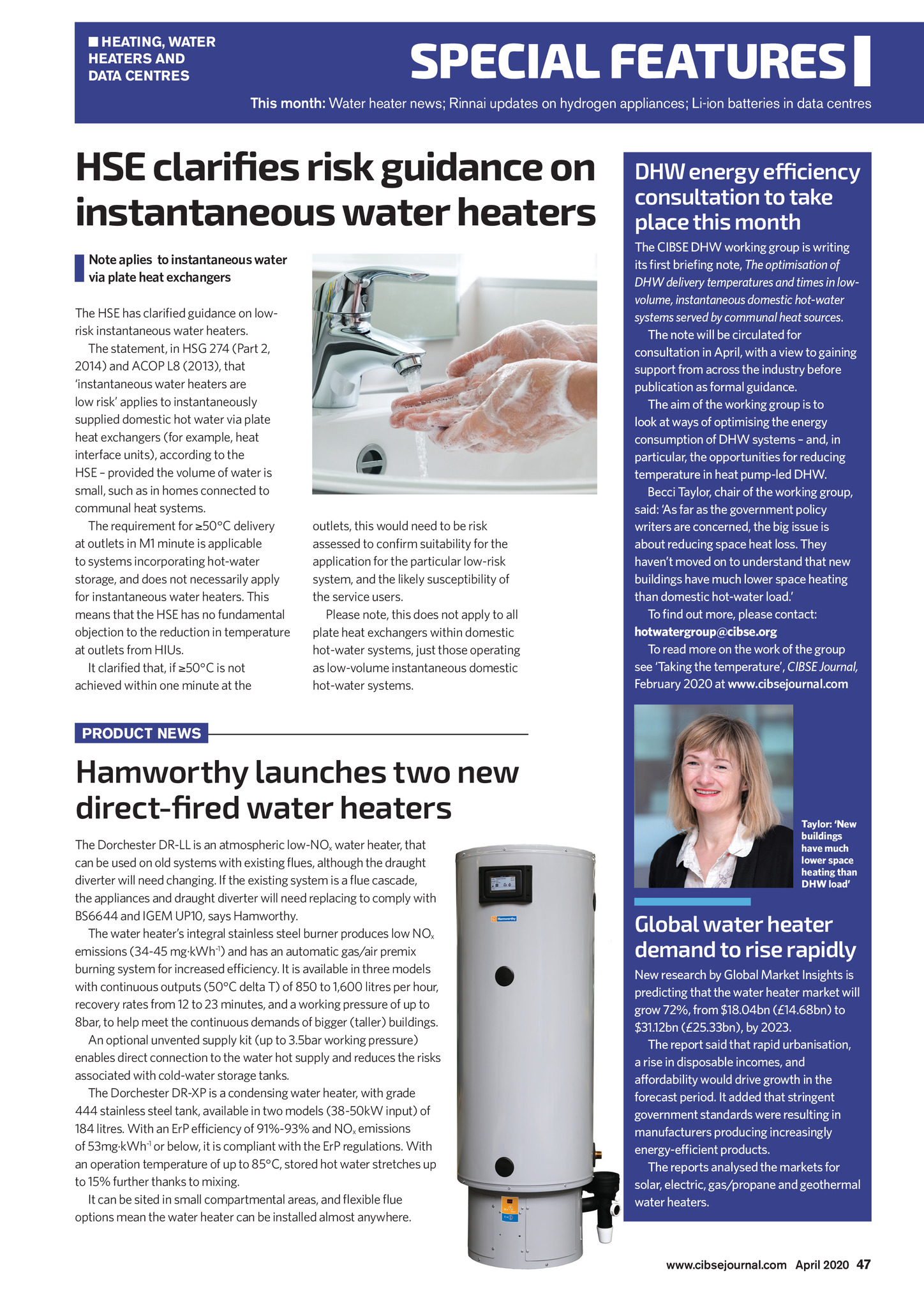


SPECIAL FEATURES HEATING, WATER HEATERS AND DATA CENTRES This month: Water heater news; Rinnai updates on hydrogen appliances; Li-ion batteries in data centres HSE clarifies risk guidance on instantaneous water heaters Note aplies to instantaneous water via plate heat exchangers The HSE has clarified guidance on lowrisk instantaneous water heaters. The statement, in HSG 274 (Part 2, 2014) and ACOP L8 (2013), that instantaneous water heaters are low risk applies to instantaneously supplied domestic hot water via plate heat exchangers (for example, heat interface units), according to the HSE provided the volume of water is small, such as in homes connected to communal heat systems. The requirement for 50C delivery at outlets in 1 minute is applicable to systems incorporating hot-water storage, and does not necessarily apply for instantaneous water heaters. This means that the HSE has no fundamental objection to the reduction in temperature at outlets from HIUs. It clarified that, if 50C is not achieved within one minute at the outlets, this would need to be risk assessed to confirm suitability for the application for the particular low-risk system, and the likely susceptibility of the service users. Please note, this does not apply to all plate heat exchangers within domestic hot-water systems, just those operating as low-volume instantaneous domestic hot-water systems. DHW energy efficiency consultation to take place this month The CIBSE DHW working group is writing its first briefing note, The optimisation of DHW delivery temperatures and times in lowvolume, instantaneous domestic hot-water systems served by communal heat sources. The note will be circulated for consultation in April, with a view to gaining support from across the industry before publication as formal guidance. The aim of the working group is to look at ways of optimising the energy consumption of DHW systems and, in particular, the opportunities for reducing temperature in heat pump-led DHW. Becci Taylor, chair of the working group, said: As far as the government policy writers are concerned, the big issue is about reducing space heat loss. They havent moved on to understand that new buildings have much lower space heating than domestic hot-water load. To find out more, please contact: hotwatergroup@cibse.org To read more on the work of the group see Taking the temperature, CIBSE Journal, February 2020 at www.cibsejournal.com PRODUCT NEWS Hamworthy launches two new direct-fired water heaters The Dorchester DR-LL is an atmospheric low-NOx water heater, that can be used on old systems with existing flues, although the draught diverter will need changing. If the existing system is a flue cascade, the appliances and draught diverter will need replacing to comply with BS6644 and IGEM UP10, says Hamworthy. The water heaters integral stainless steel burner produces low NOx emissions (34-45 mg.kWh-1) and has an automatic gas/air premix burning system for increased efficiency. It is available in three models with continuous outputs (50C delta T) of 850 to 1,600 litres per hour, recovery rates from 12 to 23 minutes, and a working pressure of up to 8bar, to help meet the continuous demands of bigger (taller) buildings. An optional unvented supply kit (up to 3.5bar working pressure) enables direct connection to the water hot supply and reduces the risks associated with cold-water storage tanks. The Dorchester DR-XP is a condensing water heater, with grade 444 stainless steel tank, available in two models (38-50kW input) of 184 litres. With an ErP efficiency of 91%-93% and NOx emissions of 53mg.kWh-1 or below, it is compliant with the ErP regulations. With an operation temperature of up to 85C, stored hot water stretches up to 15% further thanks to mixing. It can be sited in small compartmental areas, and flexible flue options mean the water heater can be installed almost anywhere. Taylor: New buildings have much lower space heating than DHW load Global water heater demand to rise rapidly New research by Global Market Insights is predicting that the water heater market will grow 72%, from $18.04bn (14.68bn) to $31.12bn (25.33bn), by 2023. The report said that rapid urbanisation, a rise in disposable incomes, and affordability would drive growth in the forecast period. It added that stringent government standards were resulting in manufacturers producing increasingly energy-efficient products. The reports analysed the markets for solar, electric, gas/propane and geothermal water heaters. www.cibsejournal.com April 2020 47 CIBSE Apr20 pp47-48 Water heater News.indd 47 23/03/2020 08:49